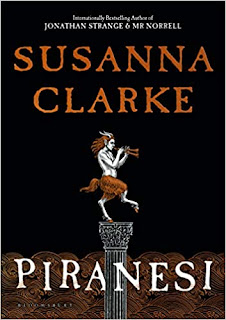Susanna Clarke: A True Narnia Fan
Warning: contains spoilers
Or you could read Susanna Clarke’s Piranesi.
It’s a strange tale of a man called Piranesi (although he’s sure that’s not his name) who lives in a House of Gormenghast-like proportions, filled with statues, birds and tides. Twice a week, he meets with “The Other”, a surprisingly well-dressed and well-equipped man, whom Piranesi assists with his great work of recovering the lost powers of the ancients. But is The Other friend or foe? Is Piranesi mad or sane? What of the entries in his journal which he cannot remember making? Are there in fact Other Worlds?
Susanna Clarke cited The Magician’s Nephew as a reference point for her great work, Jonathan Strange & Mr Norrell. And this new work also begins with a quote from The Magician’s Nephew. More than that, it explores themes drawn from The Magician’s Nephew, The Silver Chair and other Narnia books; themes that are themselves drawn from the philosophy of Owen Barfield (to whose daughter Lucy Barfield The Lion, The Witch and the Wardrobe is dedicated).
Barfield’s philosophy (or androsophy) is not easy to understand. But it does treat with the idea of Other Worlds in an intellectual space where science and magic meet.
I don’t intend to list all the ways this book interacts with Narnia and the Inklings’ ideas. A casual reader will doubtless notice the House of Statues, the Faun and the Old Dog Fox Teaching the Squirrels and Satyrs, but these are just signposts. The main and most obvious point of reference is the figure of Dr Valentine Andrew Ketterley, who not only has the same surname as Uncle Andrew and acts in the same way as Uncle Andrew with regard to magic and the Other World but it turns out is actually a descendent of the same “very old Dorsetshire family”. Like his ancestor, Val Ketterley is interested in Other Worlds for what he can get out of them, is incapable of feeling the Other World’s soul, tricks an innocent person into actually going there, and when threatened decides the solution is a Gun.
But this linking character only points us to a variety of questions and ideas straight out of Narnia. Like the Wood Between the Worlds, the House/Labyrinth leads those who go there to quickly believe they have been there always. Like Prince Rillian, Piranesi is lead to believe he is mad when actually sane and vice versa. And like Rillian, Puddleglum, Eustace & Jill, he must question whether he only imagines such things as trees and crowds because he has created them in his imagination from the “real” statues, or if the statues in fact represent things that exist in an Other World?
The idea put forth by Laurence Arne-Sayles - villain though he is - that to open the portal to Other Worlds one must regain a childlike sense of wonder - and the fact that he finds it himself in a childhood garden - recalls C.S. Lewis’ recollection of “Joy” when seeing a miniature garden as a child, something he longed for many years to rediscover. Lewis said we yearn for an Other World because it is our true home. This book leaves us with the ambiguous question: Which is the real world? Which is home?
Piranesi is The Magician’s Nephew for adults, written by an author who very much “gets” Narnia.
I don’t intend to list all the ways this book interacts with Narnia and the Inklings’ ideas. A casual reader will doubtless notice the House of Statues, the Faun and the Old Dog Fox Teaching the Squirrels and Satyrs, but these are just signposts. The main and most obvious point of reference is the figure of Dr Valentine Andrew Ketterley, who not only has the same surname as Uncle Andrew and acts in the same way as Uncle Andrew with regard to magic and the Other World but it turns out is actually a descendent of the same “very old Dorsetshire family”. Like his ancestor, Val Ketterley is interested in Other Worlds for what he can get out of them, is incapable of feeling the Other World’s soul, tricks an innocent person into actually going there, and when threatened decides the solution is a Gun.
But this linking character only points us to a variety of questions and ideas straight out of Narnia. Like the Wood Between the Worlds, the House/Labyrinth leads those who go there to quickly believe they have been there always. Like Prince Rillian, Piranesi is lead to believe he is mad when actually sane and vice versa. And like Rillian, Puddleglum, Eustace & Jill, he must question whether he only imagines such things as trees and crowds because he has created them in his imagination from the “real” statues, or if the statues in fact represent things that exist in an Other World?
The idea put forth by Laurence Arne-Sayles - villain though he is - that to open the portal to Other Worlds one must regain a childlike sense of wonder - and the fact that he finds it himself in a childhood garden - recalls C.S. Lewis’ recollection of “Joy” when seeing a miniature garden as a child, something he longed for many years to rediscover. Lewis said we yearn for an Other World because it is our true home. This book leaves us with the ambiguous question: Which is the real world? Which is home?
Piranesi is The Magician’s Nephew for adults, written by an author who very much “gets” Narnia.




Comments
Post a Comment